
Fig. 1. 1886 MHz has been identified for IMT; 27.5 GHz is under study for WRC-19. (Source: https://www.itu.int/en/ITU-D/Conferences/GSR/Documents/GSR2017/IMT2020%20roadmap%20GSR17%20V1%202017-06-21.pdf)
In early 2012, the ITU-R embarked on a program to develop “IMT for 2020 and beyond,” setting the stage for 5G research activities around the world. The ITU‑R document M.2083 defines the framework and overall objectives of IMT for 2020 and beyond. By the end of 2017, the WP 5D had already completed the documents required for driving the selection and standardization of technologies for IMT-2020 and beyond:
- “Minimum requirements related to technical performance for IMT-2020 radio interface(s)” (5/40)
- “Guidelines for evaluation of radio interface technologies for IMT-2020” (5/57)
- “Requirements, evaluation criteria, and submission templates for development of IMT-2020” (5/56)
- “Submission, evaluation process and consensus building for IMT-2020” (Doc. IMT-2020/2(Rev.1))
- Enhanced mobile broadband (eMBB) to support new user experiences such as those enabled by augmented reality/virtual reality (AR/VR).
- Massive machine-type communications (mMTC) to support machine-to-machine (M2M) services with massive numbers of end devices.
- Ultra-reliable and low latency communications (URLLC) to support unprecedented levels of reliability, availability, and quality of service, with very low latency. The minimum performance requirements for systems to qualify as IMT-2020 systems are summarized in Table 1 and Table 2.
Table 1. IMT-2020 Performance Requirements Summary
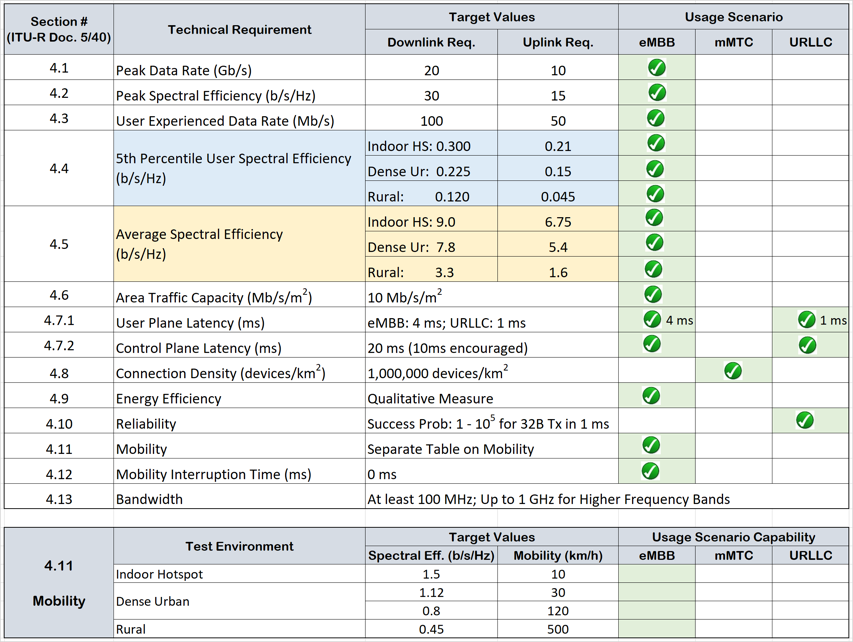
Mobility requirements for the eMBB usage scenario are summarized in Table 2.
Table 2. eMBB Mobility Requirements

The spider charts illustrated in Fig. 2 compare the performance requirements for IMT-Advanced and IMT-2020.
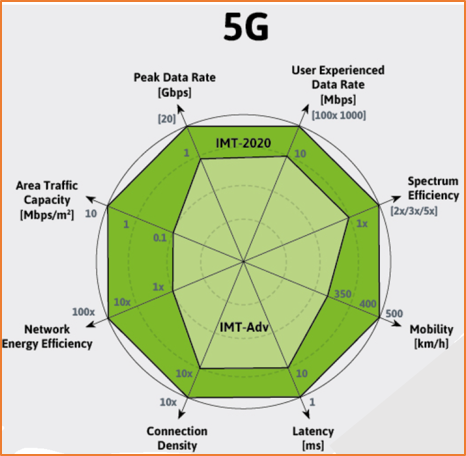 Fig. 2. Comparison of performance requirements between IMT-Advanced (“4G”) and IMT-2020 (“5G”).
(Source: https://www.ngmn.org/uploads/media/NGMN_5G_White_Paper_V1_0.pdf)
Fig. 2. Comparison of performance requirements between IMT-Advanced (“4G”) and IMT-2020 (“5G”).
(Source: https://www.ngmn.org/uploads/media/NGMN_5G_White_Paper_V1_0.pdf)
IMT-2020 (5G) is expected to be very different from its predecessors [IMT-2000 (3G) and IMT-Advanced (4G)] in that it is very likely to be a far broader platform, encompassing multiple radio access technologies (RATs), integrating with wireline connections, and supported by new network architectures built on virtualization and software-defined networking (SDN). More specifically, IMT-2020 specifications will:
- include high-frequency millimeter wave bands (e.g., 28 GHz, 39 GHz, and 60 GHz) (Table in Fig. 1);
- span licensed and unlicensed spectrum, aggregating both types together, and will also harness emerging models for spectrum sharing;
- in addition to enhanced mobile broadband (eMBB), support M2M (machine-to-machine) and IoT (Internet of Things) services that have already impacted the IMT-2020 requirements (Table 1); and
- require a whole new architecture that goes well beyond the radio and packet core to enable virtual “slices” of capacity to be assigned and optimized for specific users on-demand.
802.11 technologies (which form the basis of Wi-Fi) have been continuously evolving, bringing 5G capabilities to non-spectrum owners such as cable operators, city authorities, or private network providers. See Table 3 for a summary of the evolution of the IEEE 802.11 standard.
Table 3. Evolution of the IEEE 802.11 Standard
(Source: https://theruckusroom.ruckuswireless.com/wi-fi/2016/07/13/the-theory-of-wi-fi-evolution-and-ieee-802-11-selection/)
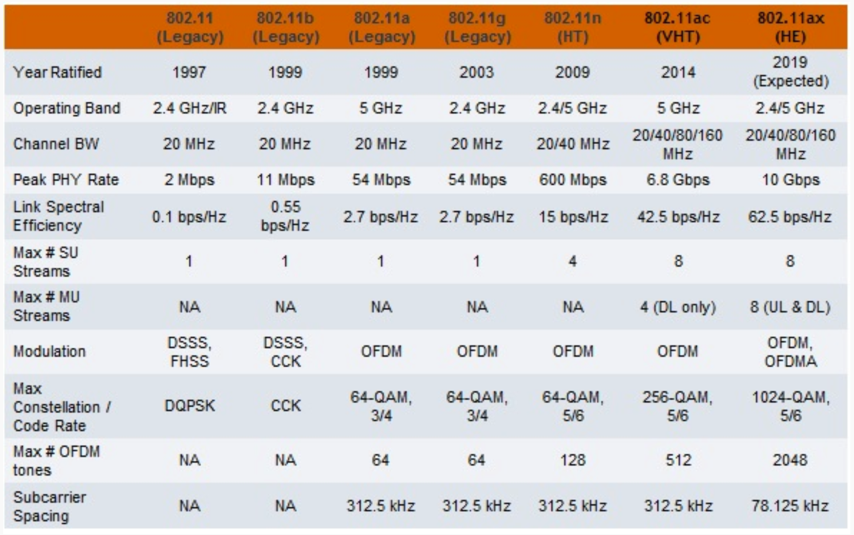
The latest IEEE 802.11 standard, 802.11ax, currently under development and seen as the first “5G” 802.11 release, is expected to be finalized in 2018. The latest commercially available Wi-Fi standard based on 802.11ac already supports multi-gigabit data rates. 802.11ax is targeted at delivering gigabit data rates in dense environments. The first pre-standard 802.11ax chipsets from various vendors have already been announced.
Table 4. IEEE 802.11ac Waveforms Compared With Other 5G Candidate Waveforms
(Source: https://mentor.ieee.org/802.11/dcn/17/11-17-1667-02-0000-tutorial-use-of-802-11-for-5g-millimeter-wave-systems.pptx)
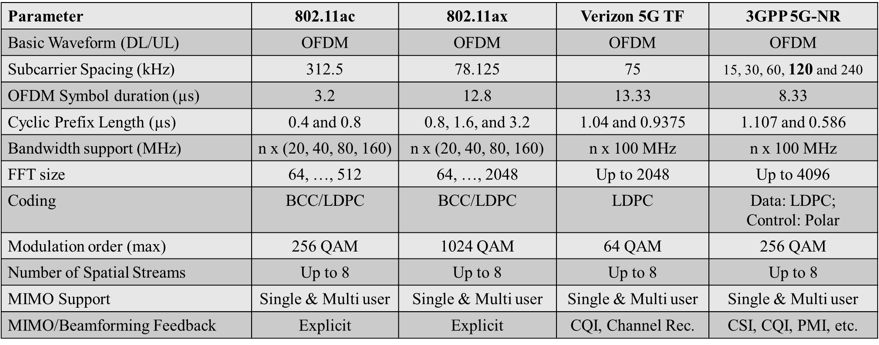
The IEEE 802.11ac and ax waveforms fare quite well when compared with 3GPP’s New Radio (NR), which is being submitted as a candidate technology for IMT-2020. Table 4 summarizes the numerology for IEEE 802.11ac, 802.11ax, Verizon 5G TF (a proprietary standard from Verizon Wireless for pre-5G deployments), and 3GPP NR systems. The suitability of the IEEE 802.11ax standard to meet the IMT-2020 requirements for hotspot environments has been studied in detail and summarized in Table 5.
Table 5. 802.11ax capabilities and IMT-2020 Requirements
(Source: https://mentor.ieee.org/802.11/dcn/18/11-18-0256-00-AANI-802-11ax-for-imt-2020.pptx )
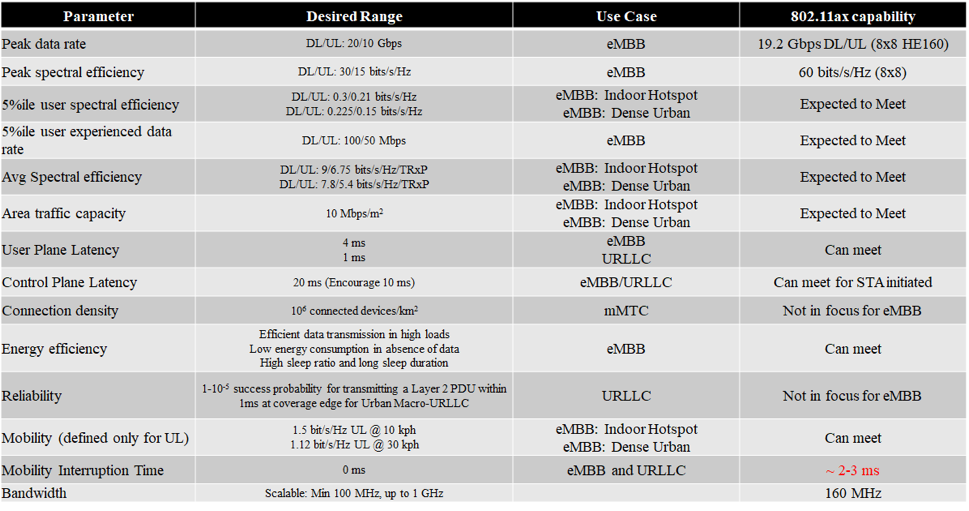
A comprehensive analysis of the suitability of the IEEE 802.11 standard to meet the IMT-2020 requirements has been documented by the Wireless Broadband Alliance in their annual industry report. Fig. 3 summarizes a key conclusion of this report, which show that the 802.11 technologies can meet and exceed the IMT-2020 requirements related to area traffic capacity and latency, but are likely to fall short in meeting the mobility requirements for very high vehicular speeds (500 km/hr). 802.11ax has focused on meeting the capacity requirement.
With each technology having its own strengths and weaknesses, it is important that operators can use and have the choice to use both 802.11 and 3GPP as well as other technologies to achieve the best overall performance in accordance with their needs.
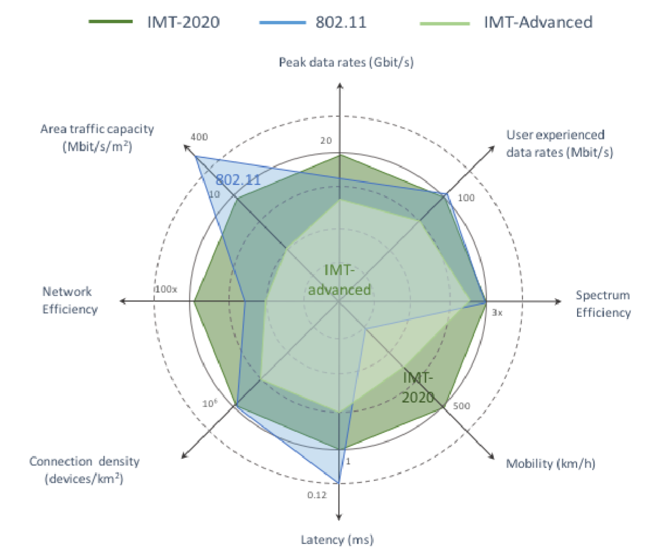
Rakesh Taori and Farooq Khan Phazr Inc., Allen, TX
